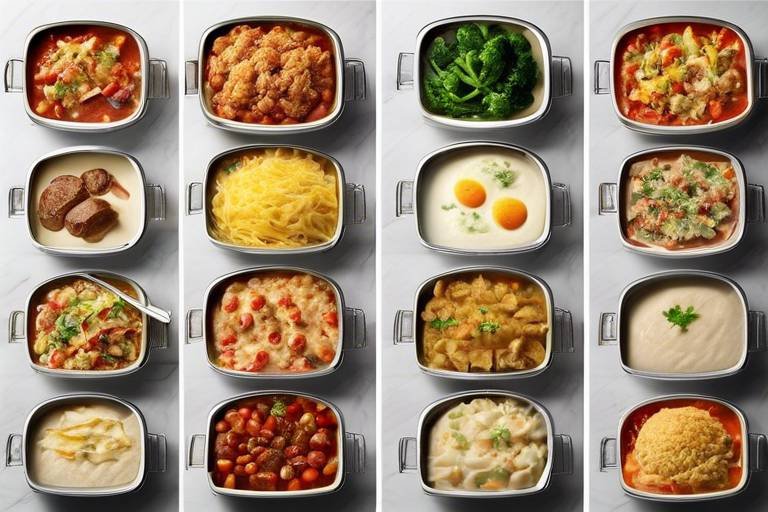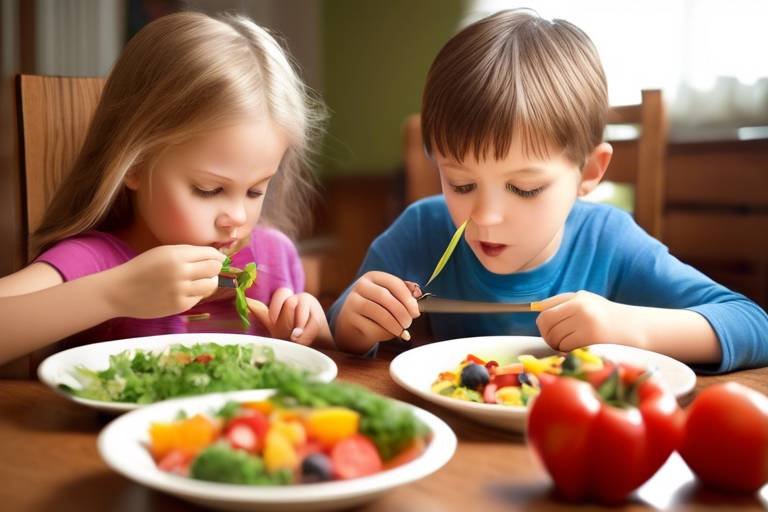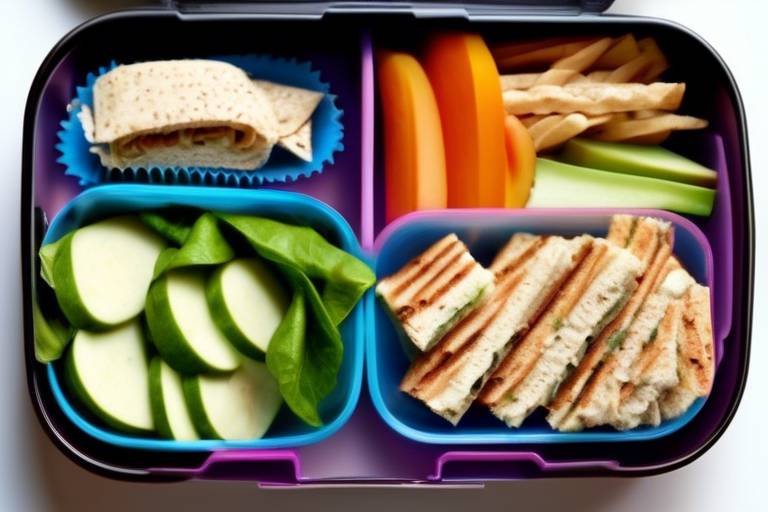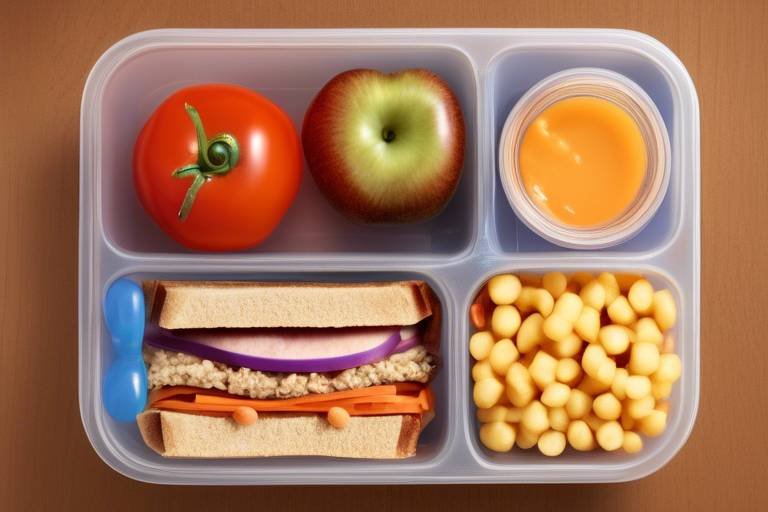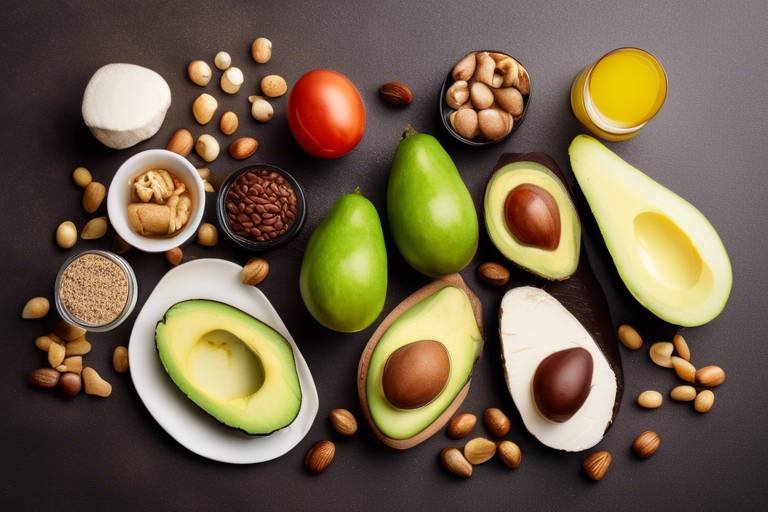How to Deal with Fussy Eaters: Nutritious and Delicious Recipes
Fussy eating can feel like a culinary battlefield, especially when it comes to children. Parents often find themselves in a tug-of-war, trying to balance the need for nutritious meals with the reality of their child's limited palate. But fear not! There are effective strategies and creative recipes that can turn mealtime into a delightful experience for both parents and picky eaters alike. Instead of viewing fussy eating as a challenge, think of it as an opportunity to explore new flavors and textures. This article dives deep into engaging ways to entice fussy eaters, ensuring they enjoy meals packed with nutrition without sacrificing taste or variety.
Fussy eating is a common phase that many children go through, and it can be incredibly frustrating for parents who want their kids to eat healthily. But what causes these picky eating habits? There are several reasons behind this behavior. For starters, children are naturally cautious about new foods; their taste buds are still developing, and they may be sensitive to certain flavors and textures. Additionally, the experience of eating is often tied to emotions and social interactions, which can influence their willingness to try new foods. Understanding these factors can help parents navigate the tricky waters of fussy eating, ensuring their children receive the necessary nutrients for healthy growth.
One of the best ways to encourage fussy eaters to try new foods is to make mealtime enjoyable. When children associate food with fun, they are more likely to explore different flavors. Think of mealtime as an adventure! Here are a couple of creative ways to present meals that capture children's interest:
Visual appeal plays a significant role in whether a child will try a new food. A plate filled with a variety of colors can be irresistible! Aim for a rainbow of fruits and vegetables to create a feast for the eyes. For instance, you might include:
- Red: Cherry tomatoes, strawberries
- Orange: Carrots, sweet potatoes
- Yellow: Bell peppers, corn
- Green: Broccoli, spinach
- Purple: Eggplant, grapes
By incorporating a range of colors, you not only make the meal visually appealing but also ensure a variety of nutrients. Children are often more willing to try foods that look fun and interesting!
Why not turn ordinary ingredients into playful masterpieces? Creating fun shapes and characters with fruits and vegetables can make healthy eating more exciting. For example, you can use cookie cutters to shape cucumbers into stars or make a funny face with sliced fruits on a pancake. The more creative you get, the more likely your child will want to dig in!
Another fantastic way to get fussy eaters involved is by offering build-your-own meal kits. Kids love the idea of customizing their plates, and this can be a great way to introduce new ingredients without overwhelming them. You can prepare simple kits with:
- Tortillas, cheese, and various toppings for DIY tacos
- Whole-grain bread, spreads, and assorted veggies for sandwiches
- Rice, beans, and a selection of proteins for bowls
By allowing children to participate in the creation of their meals, you encourage them to experiment with different flavors and textures, making healthy eating a fun and interactive experience!
Now that we’ve explored some fun ways to engage fussy eaters, let’s dive into a selection of nutritious and delicious recipes specifically designed for picky palates. Each recipe balances taste and health, appealing to even the pickiest of eaters. Whether it’s a creamy pasta dish or a colorful stir-fry, these meals are sure to please!
Getting children involved in the cooking process can significantly increase their interest in food. When they participate in preparing their meals, they develop a sense of ownership and pride, making them more likely to try new things. Here are some strategies to engage kids in meal preparation:
Assigning age-appropriate tasks can empower children in the kitchen. From washing vegetables to stirring sauces, there are plenty of simple cooking activities that children can safely participate in. Not only does this build their confidence, but it also sparks their curiosity about different ingredients and cooking methods.
Taking children grocery shopping can be an eye-opening experience. It helps them understand food choices and encourages them to try new ingredients. Make it a fun outing! Let them pick out a new fruit or vegetable to try each week. This not only expands their palate but also teaches them the importance of making healthy selections.
Q: What should I do if my child refuses to eat a certain food?
A: It's important to stay calm and patient. Encourage them to try it without pressure, and offer it again at a later date. Sometimes it takes multiple exposures for children to accept a new food.
Q: How can I ensure my child gets enough nutrients if they are picky eaters?
A: Focus on providing a variety of foods in different forms. Smoothies, soups, and dips can be great ways to incorporate fruits and vegetables without overwhelming them.
Q: Are there any foods I should avoid giving to fussy eaters?
A: While it's essential to encourage healthy eating, it's also important to avoid creating a negative association with food. Instead of banning certain foods, try to offer them in moderation alongside healthier options.

Understanding Fussy Eating
Fussy eating is a common phase that many children go through, and it can be quite a challenge for parents. Imagine preparing a delicious meal only to have your little one turn up their nose at it! This behavior can stem from various factors, including developmental stages, sensory sensitivities, and even personality traits. Children are naturally curious and often want to assert their independence, which can lead to selective eating habits. But why does this happen?
One primary reason for fussy eating is the developmental stage that children go through, particularly around the ages of 2 to 6. During this time, they are learning to navigate their world and may become more cautious about trying new foods. This is perfectly normal and can be compared to how a toddler might hesitate before stepping onto a playground slide for the first time. They need to feel secure and confident before diving into new experiences.
Another factor to consider is sensory sensitivity. Some children have heightened sensitivities to taste, texture, and smell, making certain foods unappealing or even intolerable. For instance, a child might dislike the texture of mashed potatoes but enjoy the flavor of potato chips. This is where understanding your child's preferences can make a significant difference. By recognizing their likes and dislikes, you can create meals that are both appealing and nutritious.
Additionally, social influences play a role. Kids are observant and often mimic the eating habits of their peers. If they see friends at school rejecting vegetables or opting for sugary snacks, they might follow suit. This can create a cycle of fussy eating that can be tough to break. However, it’s important to remember that these preferences can evolve over time. With patience and creativity, parents can help their children develop a more balanced diet.
Here are a few common reasons behind fussy eating:
- Independence: Children want to assert their choices.
- Developmental phases: Natural growth stages can affect eating habits.
- Sensory sensitivities: Some kids are more sensitive to tastes and textures.
- Social influences: Peers can impact food preferences.
Understanding these underlying factors is crucial for parents who wish to encourage their children to explore a wider range of foods. Instead of viewing fussy eating as a battle, consider it an opportunity to engage with your child’s tastes and preferences. By approaching meals with creativity and patience, you can help your child develop a more adventurous palate over time. Remember, it’s all about making the experience enjoyable rather than a chore!

Incorporating Fun into Meals
Making mealtime enjoyable can be a game changer when dealing with fussy eaters. The secret lies in transforming the dining experience into something fun and engaging. Imagine a dinner plate that looks like a rainbow or a meal that tells a story! By incorporating fun into meals, you not only stimulate your child's appetite but also create lasting memories around the dinner table. The goal is to make food exciting—something that children look forward to rather than dread.
One effective strategy is to use creativity in presentation. Children are naturally drawn to bright colors and whimsical shapes, so why not use that to your advantage? For instance, you could arrange fruits and vegetables in a way that resembles their favorite cartoon characters or animals. This playful approach can turn a simple meal into a delightful adventure, sparking curiosity and encouraging them to taste what’s on their plate. You might be surprised at how many new foods they’ll try when they’re presented in a fun and appealing way!
Creating a colorful plate is not just about aesthetics; it’s also a fantastic way to introduce a variety of nutrients into your child's diet. A plate filled with different colors often represents a range of fruits and vegetables, each packed with unique vitamins and minerals. For example, you can include:
- Red: Tomatoes, strawberries, and red bell peppers
- Green: Spinach, broccoli, and green apples
- Yellow: Corn, bananas, and yellow squash
- Purple: Eggplant, blueberries, and purple cabbage
By mixing and matching these colorful ingredients, you create a feast for the eyes that can make even the pickiest eater curious enough to take a bite. And remember, the more colors on the plate, the more nutrients your child is likely to consume!
Have you ever thought about turning dinner into art? With a little creativity, you can transform ordinary fruits and vegetables into playful masterpieces. For instance, you could use cucumber slices for the body and cherry tomatoes for the head to create a funny little caterpillar. Or, how about arranging carrot sticks and bell pepper strips to form a colorful flower? The possibilities are endless! This not only makes the meal visually appealing but also encourages children to engage with their food in a positive way.
Another exciting way to involve fussy eaters is by offering DIY meal kits. Imagine a taco night where kids can build their own tacos, choosing from a variety of toppings like cheese, lettuce, and salsa. This interactive approach allows children to take control of their meals, making them feel empowered and more willing to try new flavors. You can easily create these kits at home with items like:
| Base | Toppings | Sauces |
|---|---|---|
| Tortillas | Shredded chicken, beans, cheese | Salsa, guacamole, sour cream |
| Rice bowls | Grilled veggies, tofu, or shrimp | Teriyaki sauce, soy sauce |
By allowing children to customize their plates, you not only make mealtime fun but also encourage them to explore different combinations of flavors and textures. Who knows? They might discover a new favorite dish in the process!

Colorful Plate Ideas
When it comes to enticing fussy eaters, one of the most effective strategies is to create colorful plates that are as visually appealing as they are nutritious. Imagine a plate bursting with vibrant colors—greens, reds, yellows, and purples. It’s like a rainbow on a plate! This not only captures the attention of picky eaters but also encourages them to explore new flavors. The key is to incorporate a variety of fruits and vegetables, making sure each meal is a feast for the eyes.
To achieve this, consider using a mix of different food groups. For instance, you could create a colorful salad featuring spinach (green), cherry tomatoes (red), shredded carrots (orange), and purple cabbage. Not only does this combination look enticing, but it also provides an array of vitamins and minerals essential for growth. You could even turn this salad into a fun activity by letting your kids choose their favorite colors and toppings, making them more likely to dig in.
Another fun idea is to create a color-coded meal. For example, you could serve a plate with:
- Red: Cherry tomatoes or red bell peppers
- Orange: Sweet potato wedges or carrots
- Yellow: Corn or yellow squash
- Green: Broccoli or peas
- Purple: Eggplant or purple grapes
This not only makes the meal visually appealing but also introduces children to the concept of eating a rainbow of foods. The more colors on their plate, the more nutrients they are likely to consume. You could even turn this into a game where kids earn points for trying foods of different colors!
Don’t forget to play with shapes and textures. Using cookie cutters to create fun shapes from fruits and vegetables can add an element of surprise to the meal. For example, star-shaped cucumbers or flower-shaped carrots can make a simple snack feel like a special treat. Pair these shapes with dips like hummus or yogurt to make them even more enticing. The crunch of a fresh veggie combined with a creamy dip can be a delightful experience for little taste buds.
Finally, consider the use of themed meals. You could create a Mediterranean-themed dinner with colorful tabbouleh, hummus, and pita bread, or a Mexican fiesta with vibrant guacamole, salsa, and colorful peppers. Themed meals not only provide variety but also make the dining experience more engaging. You can even involve your children in choosing the theme, which can further pique their interest in the food.
In conclusion, creating colorful plates is a fantastic way to entice fussy eaters. By mixing different colors, shapes, and themes, you can transform mealtime into an adventure that encourages kids to try new foods. Remember, the goal is to make healthy eating fun and enjoyable, paving the way for a lifetime of good nutrition!

Fruit and Vegetable Art
Creating is not just a fun activity; it's a fantastic way to make healthy eating exciting for fussy eaters! Imagine a plate where broccoli trees stand tall next to carrot sticks shaped like a sun, all surrounded by a rainbow of fruits. This playful presentation can transform mealtime from a chore into a delightful adventure. By turning ordinary ingredients into playful masterpieces, you can stimulate your child's imagination and appetite.
To get started, gather a variety of colorful fruits and vegetables. The more colors you have, the more visually appealing your creations will be. For instance, you might use:
- Red: Strawberries, cherry tomatoes, red bell peppers
- Green: Cucumbers, broccoli, grapes
- Yellow: Corn, bananas, yellow bell peppers
- Purple: Eggplant, purple grapes, plums
Once you have your ingredients, let your creativity shine! You can use cookie cutters to create fun shapes or simply slice fruits and vegetables into interesting forms. For example, a simple apple can be transformed into a smiling face with some banana slices for eyes and a strawberry for a nose. The key is to make it look inviting and fun. You might even consider creating themed plates, like a ocean scene with blue yogurt as the sea and fish-shaped crackers swimming around!
Engaging your child in this creative process can also spark their interest in trying new foods. You can ask questions like, "What do you think a flower made of cucumber and cherry tomatoes would taste like?" or "How about we make a dinosaur using broccoli and green beans?" Such questions not only pique their curiosity but also encourage them to take part in the fun of food preparation.
In addition to being visually appealing, fruit and vegetable art can be a great conversation starter at the dinner table. You can share fun facts about the ingredients you used or even tell stories that relate to the shapes you've created. For instance, you could say, "Did you know that carrots help you see in the dark? That's why we made them into little superhero shields!" This way, you’re not just feeding their bodies but also their minds.
In conclusion, is an innovative way to engage fussy eaters and promote healthy eating habits. By making food visually enticing and involving children in the creation process, you can help them develop a positive relationship with their meals. So, roll up your sleeves, grab those fruits and veggies, and start creating edible art that will have your little ones excited to eat!
Q: How can I encourage my child to try new fruits and vegetables?
A: Involve them in the cooking and presentation process, and make it fun! Use creative shapes and colors to make the food visually appealing.
Q: What if my child refuses to eat fruits and vegetables altogether?
A: Start small by incorporating fruits and vegetables into their favorite dishes or smoothies. Gradually introduce new flavors without pressure.
Q: Can fruit and vegetable art be prepared in advance?
A: Yes! You can prepare some elements in advance, but it's best to assemble the art just before serving to keep everything fresh and visually appealing.

DIY Meal Kits
Creating is an innovative way to engage fussy eaters while allowing them to express their creativity and preferences. Imagine a world where your child becomes a little chef, excitedly assembling their meals just the way they like it! This approach not only encourages them to try new ingredients but also makes mealtime a fun and interactive experience. So, how do you create these magical kits? It's simpler than you might think!
First, gather a variety of ingredients that are both nutritious and appealing. Think of colorful vegetables, lean proteins, and whole grains. For instance, you could include items like:
- Whole grain tortillas or pita bread
- Cooked chicken strips or turkey slices
- Cheese cubes or shredded cheese
- Chopped veggies like bell peppers, cucumbers, and carrots
- Dips such as hummus or yogurt-based dressings
Next, present these ingredients in a fun and organized manner. You could use small containers or compartments to separate each item, making it visually appealing and easy for your child to see what they have to work with. This not only sparks their interest but also provides a sense of autonomy as they choose what to include in their meal.
One great idea is to theme your meal kits. For example, you could create a Taco Night Kit with all the fixings for tacos, or a Pizza Party Kit with various toppings. By giving them a theme, you can make the experience even more exciting! Encourage your child to mix and match ingredients, creating their own unique dishes. This kind of flexibility can help them feel more in control, which is often a key factor in overcoming picky eating habits.
Don't forget to get creative with the presentation! You can use cookie cutters to shape tortillas or veggies into fun designs. Make it a game where they can create their own food art. This playful approach not only makes the meal more enjoyable but also helps them develop a positive relationship with healthy foods.
Finally, encourage your child to share their creations with the family. This not only boosts their confidence but also allows them to take pride in their culinary achievements. Who knows? You might even discover a new family favorite dish along the way!
In summary, DIY meal kits are an excellent way to transform the daunting task of mealtime into a delightful adventure. By allowing children to customize their meals, you can help them explore new flavors in a fun and engaging way. Remember, the goal is to make healthy eating enjoyable, and with a little creativity, you can turn any meal into a masterpiece!

Flavorful Recipes to Try
When it comes to fussy eaters, the key is to blend nutrition with flavor in a way that excites their taste buds. Here are a few recipes that are not only nutritious but also delicious, making them perfect for even the pickiest eaters.
First up, we have the Rainbow Veggie Wraps. These wraps are a feast for the eyes and the palate! Start with a whole grain tortilla and layer it with a variety of colorful veggies like bell peppers, carrots, and spinach. Add a spread of hummus or cream cheese for a creamy texture that kids love. Roll it up tight, slice it into bite-sized pieces, and watch your little ones munch away happily. This recipe is fantastic because it not only provides essential vitamins but also encourages kids to enjoy a spectrum of flavors.
Next on the list is Cheesy Cauliflower Bites. These little nuggets are a great way to sneak in some veggies without any fuss. Simply steam cauliflower florets until tender, then mash them up with cheese, breadcrumbs, and a sprinkle of garlic powder. Bake them until golden brown, and you've got a crunchy snack that’s hard to resist! The cheesy flavor masks the taste of the cauliflower, making it a hit with even the most discerning palates.
Now, let’s talk about Fruit and Yogurt Parfaits. This recipe is as easy as it gets and perfect for breakfast or a snack. Layer Greek yogurt with a mix of fruits like strawberries, blueberries, and banana slices in a clear cup. Add a sprinkle of granola on top for some crunch. Not only does it look appealing, but it also packs a protein punch and is loaded with antioxidants. Plus, kids can help assemble their own parfaits, making it a fun activity as well!
Another delightful dish is the Pasta Primavera. This colorful pasta dish is loaded with seasonal vegetables like zucchini, cherry tomatoes, and peas. Cook your favorite pasta, sauté the veggies with a bit of olive oil and garlic, and toss everything together with a sprinkle of parmesan cheese. The combination of flavors and textures will have your kids asking for seconds, and it’s a fantastic way to introduce them to new vegetables in a familiar format.
To make meal planning even easier, consider creating a weekly meal chart that includes these recipes. Here’s a simple table to help you organize your meals:
| Day | Recipe |
|---|---|
| Monday | Rainbow Veggie Wraps |
| Tuesday | Cheesy Cauliflower Bites |
| Wednesday | Fruit and Yogurt Parfaits |
| Thursday | Pasta Primavera |
| Friday | DIY Pizza Night |
Each of these recipes is designed to not only satisfy picky eaters but also to instill a love for healthy foods. The secret is to keep trying new things, even if they initially get turned down. With a little creativity and patience, mealtime can transform from a battleground into a delightful experience that everyone looks forward to.
Q: How can I encourage my child to try new foods?
A: Start by introducing new foods alongside their favorites. Make it a fun experience by involving them in the cooking process or presenting the food in a creative way.
Q: What if my child refuses to eat vegetables?
A: Try sneaking vegetables into dishes they already enjoy, like blending spinach into a smoothie or adding finely chopped veggies into pasta sauce.
Q: Are there any quick snacks I can prepare for fussy eaters?
A: Absolutely! Consider options like cheese sticks, apple slices with peanut butter, or yogurt with honey and granola.

Involving Children in Cooking
Getting children involved in the cooking process can be a game changer when it comes to their eating habits. Imagine the excitement on their faces as they stir, mix, and create delicious dishes alongside you! Not only does this foster a sense of independence and responsibility, but it also helps cultivate a positive relationship with food. When kids participate in cooking, they're more likely to try new foods and develop a broader palate. This hands-on experience can turn mealtime into an adventure rather than a chore.
One effective strategy is to assign age-appropriate tasks that match your child's skill level. For instance, toddlers can help wash fruits and vegetables, while older children can take on more complex tasks like chopping (with supervision, of course) or measuring ingredients. This not only builds their confidence but also allows them to feel a sense of ownership over their meals. You might be surprised at how much more willing they are to eat something they've had a hand in preparing!
Another engaging way to involve kids in cooking is by taking them grocery shopping. This experience is not just about picking up ingredients; it’s an opportunity for children to learn about different foods, where they come from, and how to make healthier choices. As you stroll through the aisles, encourage them to pick out a new fruit or vegetable to try. This can spark their curiosity and make them excited about experimenting with new recipes at home. Plus, discussing the nutritional benefits of various foods can help them understand the importance of a balanced diet.
Involving children in the cooking process can also lead to some fun family bonding moments. You could turn on some music and have a little dance party while you cook, or set up a friendly competition to see who can create the best dish with the ingredients available. These shared experiences not only make cooking enjoyable but also create lasting memories that can influence their attitudes toward food for years to come.
To summarize, involving children in cooking is a fantastic way to encourage healthy eating habits. It empowers them, makes meals more exciting, and helps them form a positive connection with food. So, roll up your sleeves, gather your little chefs, and start creating delicious meals together!
- What age should I start involving my child in cooking?
It's never too early to start! Even toddlers can help with simple tasks like washing vegetables. - How can I ensure my child stays safe in the kitchen?
Always supervise them closely, teach them about kitchen safety, and provide age-appropriate tasks. - What if my child refuses to try new foods?
Encourage them to taste new ingredients in a fun way, perhaps through dips or creative presentations.

Simple Cooking Tasks
Getting children involved in the kitchen can be a game-changer when it comes to fussy eating. not only empower kids but also spark their curiosity about food. Imagine your little one proudly declaring, "I made that!" after helping prepare a meal. It’s all about making cooking a fun and engaging experience. So, what are some easy tasks that kids can tackle? Here are a few ideas:
Start with the basics. Washing fruits and vegetables is a simple task that even the youngest chefs can handle. Not only does it teach them about cleanliness in the kitchen, but it also gives them a sense of ownership over the food they're about to eat. You could turn this into a mini-science lesson by discussing why washing produce is important. Next, let them tear lettuce or herbs for salads. This requires minimal supervision and is a great way for them to contribute to a healthy dish.
As they grow more confident, introduce them to measuring ingredients. This task can be both fun and educational, as it incorporates math skills. You can create a little competition by timing them or challenging them to see who can measure more accurately. Cooking is a fantastic way to sneak in some learning without them even realizing it!
Another exciting task is mixing and stirring. Whether it's batter for pancakes or a sauce for pasta, let them take charge of the mixing. You can make it even more enjoyable by counting the number of stirs together or creating a little dance while they mix. This not only makes cooking fun but also helps them develop motor skills.
Don’t forget about assembling dishes. Let them build their own pizzas or tacos. This is where creativity shines! You can set out a variety of toppings and let them choose what they want. This not only gives them control over what they eat but also encourages them to try new flavors in a way that feels safe and exciting.
Lastly, cleaning up can also be a part of the experience. Teach them the importance of tidiness in the kitchen. Make it a game: who can clean up the fastest? This instills a sense of responsibility and teamwork, which are valuable life skills.
Involving children in these simple cooking tasks not only makes them more inclined to try new foods but also fosters a positive relationship with cooking and nutrition. The joy of creating something together can transform mealtime from a battle into a bonding experience.
Q: At what age can I start involving my child in cooking?
A: You can start as early as 2-3 years old with simple tasks like washing fruits and vegetables. As they grow older, you can introduce more complex tasks.
Q: What if my child refuses to try new foods?
A: Be patient and keep offering new foods alongside familiar favorites. Involving them in cooking can also make them more open to trying new things.
Q: How can I make cooking more enjoyable for my child?
A: Turn it into a game! Use timers, create challenges, or have theme nights where you cook dishes from different countries. The more fun it is, the more likely they are to participate.
Q: Are there any safety tips I should consider?
A: Always supervise your child in the kitchen. Start with tasks that are safe for their age and skill level, and gradually introduce more complex tasks as they gain confidence.

Grocery Shopping Together
Taking your kids grocery shopping can be a game changer when it comes to battling fussy eating habits. Imagine this: you're navigating the aisles, and instead of hearing complaints about what's on the menu, your little ones are excitedly pointing out colorful fruits and veggies. By involving them in the shopping process, you're not just filling your cart; you're also filling their minds with curiosity about food. When children participate in selecting their ingredients, they develop a sense of ownership over their meals, which can lead to a more adventurous palate.
One effective strategy is to create a fun and engaging shopping list together. Let your kids help choose items to add to the list. This way, they feel like they're part of the decision-making process. For instance, you might say, “How about we pick a new fruit to try this week?” This simple question can spark a conversation that leads to them suggesting exotic fruits like dragon fruit or starfruit, which they might otherwise overlook. Plus, it gives you the opportunity to teach them about the health benefits of various foods as you go along.
As you stroll through the store, encourage your children to explore different sections. You can turn this into a mini-adventure by asking them to find a specific color of fruit or vegetable. For example, “Can you find something that’s orange?” This not only makes shopping fun but also helps them learn about nutrition and the importance of variety in their diet. You can even create a little challenge: whoever spots the most items from the list gets to pick a special treat for the week. This adds an element of excitement and competition, making shopping a delightful experience.
Moreover, discussing the different food groups while you shop can be an educational experience. You might say, “Look at all these different grains! Which ones do you want to try?” This encourages them to think critically about their food choices and helps them understand the importance of a balanced diet. You can even introduce them to new ingredients that you could cook together later, such as quinoa or lentils, explaining how they can be used in meals.
Here’s a quick table summarizing some tips for grocery shopping with kids:
| Tip | Description |
|---|---|
| Make a Fun List | Let kids choose items to add to the shopping list. |
| Color Hunt | Ask kids to find fruits or veggies of a specific color. |
| Food Group Discussion | Talk about different food groups and their benefits. |
| Special Treat Challenge | Incentivize them to spot items by offering a treat. |
Involving your children in grocery shopping not only makes the experience enjoyable but also lays the groundwork for healthier eating habits in the future. When they feel invested in the process, they are more likely to be excited about the meals you prepare together. So, the next time you're headed to the store, consider turning it into a family outing. Who knows? You might just discover that your fussy eater is ready to embrace new flavors and textures!
Q: How can I encourage my child to try new foods?
A: Start by involving them in the shopping and cooking process. Let them choose new ingredients and help prepare meals. This can spark their interest in trying new foods.
Q: What if my child refuses to eat certain foods?
A: It's important to remain patient. Offer the food multiple times without pressure. Sometimes, it takes several exposures for a child to accept a new food.
Q: Are there any special techniques for making vegetables more appealing?
A: Yes! Try incorporating vegetables into fun shapes, or blend them into smoothies. Adding dips or sauces can also make them more enticing.
Q: How can I make grocery shopping more educational for my child?
A: Use shopping time to teach them about nutrition, food groups, and the importance of variety. Turning it into a game can also make learning fun.
Frequently Asked Questions
- What causes fussy eating in children?
Fussy eating can stem from a variety of factors, including developmental stages, sensory sensitivities, and even parental influences. Children may be naturally cautious about new foods, or they might have had negative experiences with certain tastes or textures. Understanding these reasons can help parents navigate mealtime challenges.
- How can I make meals more appealing to fussy eaters?
Making meals visually appealing is key! Try to incorporate a rainbow of colors on the plate, use fun shapes, and create playful food art. Engaging children in the cooking process can also spark their interest. When they help prepare their meals, they’re often more excited to eat them!
- What are some easy recipes for picky eaters?
Some great recipes for picky eaters include colorful veggie wraps, fruit kabobs, and DIY mini pizzas. These meals not only allow for customization but also incorporate a variety of nutritious ingredients that can be tailored to your child's taste preferences.
- How can I involve my child in grocery shopping?
Involving your child in grocery shopping can be a fun adventure! Let them help create a shopping list, choose fruits and vegetables, or even select a new recipe to try. This hands-on experience can make them more curious about food and more willing to try new things.
- Are there any strategies to encourage my child to try new foods?
Absolutely! Try introducing new foods alongside familiar favorites, and encourage small, no-pressure tastes. Make it a game or a challenge, and celebrate their willingness to try something new, no matter how small. Positive reinforcement can go a long way!
- What if my child refuses to eat healthy foods?
If your child refuses healthy foods, don’t panic! Keep offering them in different forms, like smoothies, dips, or baked dishes. Sometimes, it takes multiple exposures before a child is willing to try something new. Patience is key!



